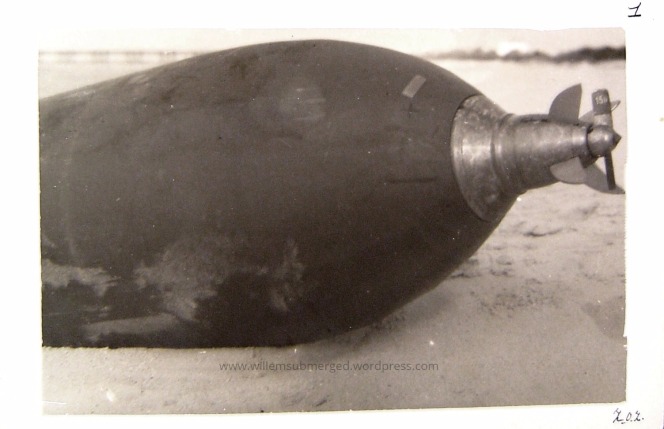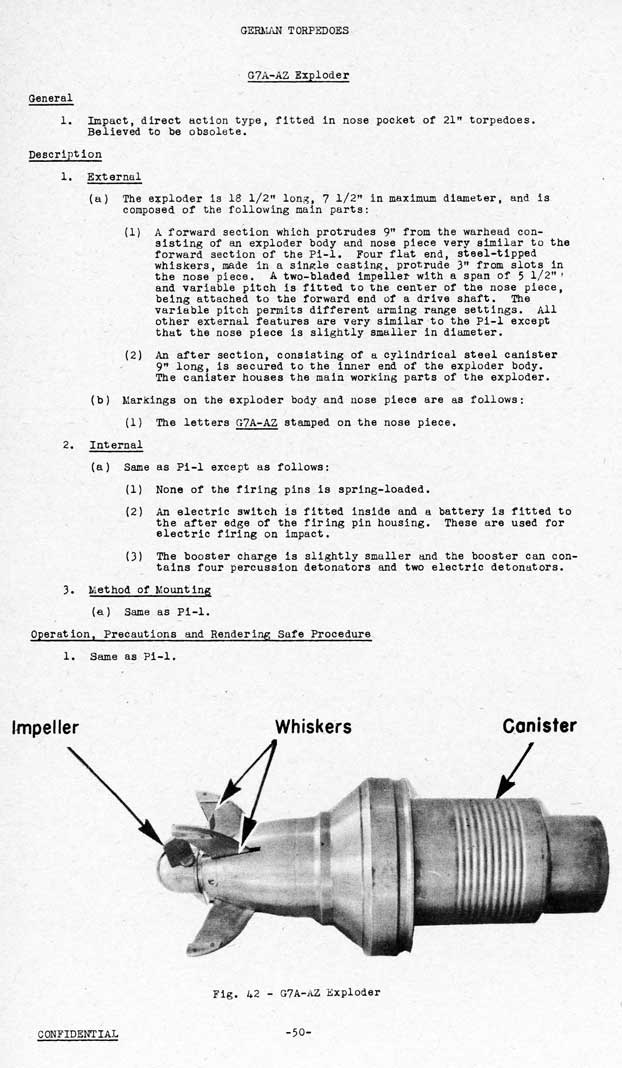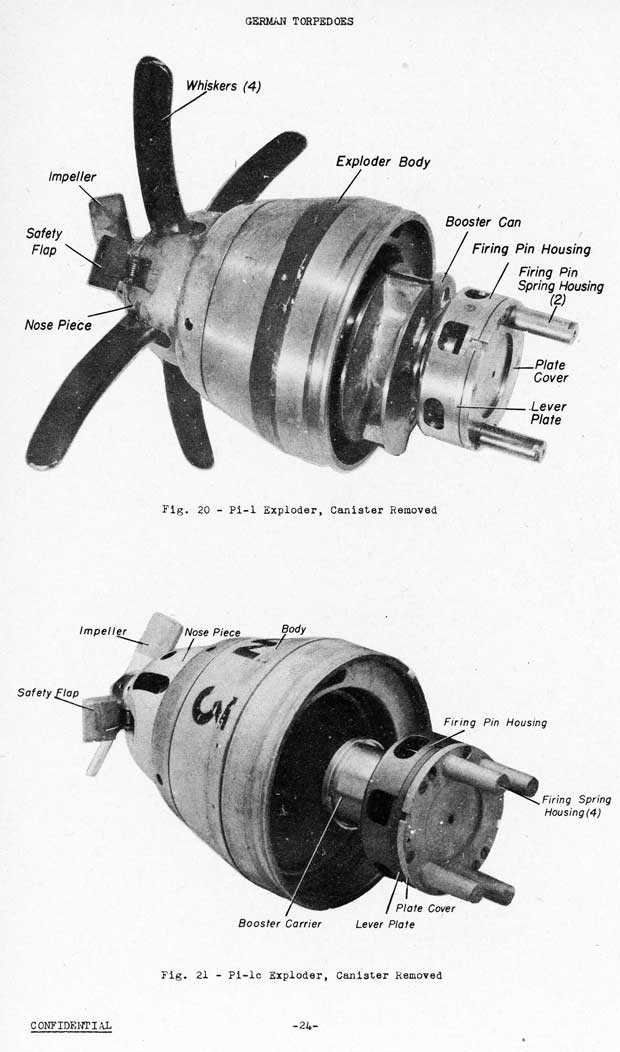Technology and Operations
This forum is for discussing technological & operational matters pertaining to U-boats.
Re: British influence on German torpedo design
Posted by:
SnakeDoc
()
Date: January 28, 2017 11:09PM
Hi,
it is an interesting question and the answer is not obvious. Before I try to answer, I will present some background.
HMS Seal was captured in May 1940, with 6 Mark VIII wet-heater torpedoes, fitted with Type 3 contact pistol.
It was the time just after Operation Weserübung, when the torpedo crisis totally revealed. The torpedo crisis was caused by three factors:
1. poor depth-keeping (flaws in depth-gear design);
2. premature explosions of the influence (magnetic) pistol;
3. not working impact pistol;
Regarding the pistol problems, in that time, German torpedoes (G7a and G7e) were fitted with the pistol designated as Pi G7a. It consisted of two parts: impact (AZ - Aufschlagzünder) and influence (MZ - Magnetzünder) part. Both parts were not working properly.
It is said that British Type 3 pistols from captured HMS Seal were basis of the new German pistol, designed and developed as a solution of the problems with Pi G7a AZ.
How Pi G7a pistol look like, you can see on the pictures of so called Aruba torpedo:

In fact, this is G7e torpedo beached on the Curaçao, more information you can find here:
[willemsubmerged.wordpress.com]
Here is one more picture:

From the Mine Disposal Handbook [maritime.org]
Pistol Pi G7a was developed in 1934, and generally it was derived from the Whitehead type exploder:

More information here: [archive.hnsa.org]
Generally, this Whitehead type exploder worked as follows: when the torpedo hits the hull, the one (or more) of four whiskers are pushed backward, together with firing pin (1). Firing pin strikes the forward exploder (6) and initiate the detonation of the war head explosive charge.
The Pi G7a four whiskers are also fixed to the shaft, but at the end of the shaft there is no firing pin. When whiskers strike the hull, they push the shaft backward, and the other end of the shaft actuates two levers, so the backward movement of the shaft is reversed. One lever closes contacts of the electric detonator, and the other moves the firing pin forward, to hit the boost charge and initiate detonation.
The electric detonator was added as a redundant way of the initiating detonation, and as a "execute stage" of the influence part of the pistol.
The small impeller at the front of the pistol is used to arm the pistol after travelling some safety distance (when it rotates, it moves the boost charge towards the firing pins).
I have made small sketch to my brief description:

In theory, the Pi G7a type pistol intended to work for angle of impact from 21 to 159 degrees.
But this design appeared to be faulty.
Karl Dönitz in his book "Memoirs: Ten Years and Twenty Days" blames the introduction of two levers and changing the thrust direction.
However, trials conducted during the war (which should be conducted before introducing the pistol into the service) showed that when angle of impact was out of range 50-130 (that is much below the Kriegsmarine requirements), the whiskers jammed and the shaft was not pushed enough backward to actuate firing pin or electric contacts. Moreover, when torpedo heeled, the effective angle of impact was even less.
When Germans captured the HMS Seal, they investigated British Type 3 impact pistol. I was not able to find picture of this pistol, however it looks similar to this impact pistol installed at British airborne Mk XII torpedo:

(Source: [www.kbismarck.org]
Here is cross-section:

(Source: [www.navalofficer.com.au]
Generally, it was impact pistol with 6 whiskers acting as impeller, moving the boost charge forward (toward the firing pins), as the torpedo traveled the safety distance. Moreover, the rotating impeller tensed the firing spring. When the whiskers strike the target, they pushed the shaft, the shaft released the firing pins, which forced by the firing spring hit the boost charge.
On 22 May 1940, Dönitz wrote in his KTB:
"A thorough examination of the (Pi G7a - my note) pistol showed a number of faults in construction, and improvement and adaptation of various parts were begun.
Independently of this, I demanded that the English impact pistol captured in "Seal" be copied. We were to go over to "AZ" as soon as the pistol was in order for impact firing."
(Source: [www.uboatarchive.net])
Germans made a copy of the Type 3 pistol, designated as Pi 40 and manufactured 2000 of them.
However, during the trials it turned out that torpedoes fitted with Pi 40 pistol run unstable and hit the ground.
The solution of the problems with impact pistol was the brand new design, designated as Pi 1. This pistol was derived from the design designated as G7h from 1939, especially suitable for small impact angles (7-173 degrees). Pi 1 pistol was in use since mid-1940.

(Source: [maritime.org])

Its operating principle was similar to the operating principle of the Pi G7a pistol. It had four whiskers, longer than in Pi G7a and bent backward (instead forward). When wiskers stroke the hull, they pushed the shaft, the shaft pushed the lever (so the thrust was reversed, as in case Pi G7a pistol), and the lever pushed the firing pin. The main difference was that firing pin was spring loaded.
And this design was working. The Pi 1 was used later as an impact exploder of the Pi 2 pistol, which combined also successful influence exploder.
So one can tell that although Germans tried to solve their problems with impact pistols by copying British Type 3 pistol, they did not succeed. Were they inspired by solutions used in British pistols? They (again) reversed the thrust (as in case of Pi G7a), they used four whiskers and separate impeller, they bend the whiskers backwards (contrary to straight whiskers in British pistol). The common thing was spring-loaded firing pin.
Summarizing, I think that influence of the British Type 3 pistol was much less than it is generally believed.
--
Regards
Maciek

[www.tvre.org]
it is an interesting question and the answer is not obvious. Before I try to answer, I will present some background.
HMS Seal was captured in May 1940, with 6 Mark VIII wet-heater torpedoes, fitted with Type 3 contact pistol.
It was the time just after Operation Weserübung, when the torpedo crisis totally revealed. The torpedo crisis was caused by three factors:
1. poor depth-keeping (flaws in depth-gear design);
2. premature explosions of the influence (magnetic) pistol;
3. not working impact pistol;
Regarding the pistol problems, in that time, German torpedoes (G7a and G7e) were fitted with the pistol designated as Pi G7a. It consisted of two parts: impact (AZ - Aufschlagzünder) and influence (MZ - Magnetzünder) part. Both parts were not working properly.
It is said that British Type 3 pistols from captured HMS Seal were basis of the new German pistol, designed and developed as a solution of the problems with Pi G7a AZ.
How Pi G7a pistol look like, you can see on the pictures of so called Aruba torpedo:

In fact, this is G7e torpedo beached on the Curaçao, more information you can find here:
[willemsubmerged.wordpress.com]
Here is one more picture:

From the Mine Disposal Handbook [maritime.org]
Pistol Pi G7a was developed in 1934, and generally it was derived from the Whitehead type exploder:

More information here: [archive.hnsa.org]
Generally, this Whitehead type exploder worked as follows: when the torpedo hits the hull, the one (or more) of four whiskers are pushed backward, together with firing pin (1). Firing pin strikes the forward exploder (6) and initiate the detonation of the war head explosive charge.
The Pi G7a four whiskers are also fixed to the shaft, but at the end of the shaft there is no firing pin. When whiskers strike the hull, they push the shaft backward, and the other end of the shaft actuates two levers, so the backward movement of the shaft is reversed. One lever closes contacts of the electric detonator, and the other moves the firing pin forward, to hit the boost charge and initiate detonation.
The electric detonator was added as a redundant way of the initiating detonation, and as a "execute stage" of the influence part of the pistol.
The small impeller at the front of the pistol is used to arm the pistol after travelling some safety distance (when it rotates, it moves the boost charge towards the firing pins).
I have made small sketch to my brief description:

In theory, the Pi G7a type pistol intended to work for angle of impact from 21 to 159 degrees.
But this design appeared to be faulty.
Karl Dönitz in his book "Memoirs: Ten Years and Twenty Days" blames the introduction of two levers and changing the thrust direction.
However, trials conducted during the war (which should be conducted before introducing the pistol into the service) showed that when angle of impact was out of range 50-130 (that is much below the Kriegsmarine requirements), the whiskers jammed and the shaft was not pushed enough backward to actuate firing pin or electric contacts. Moreover, when torpedo heeled, the effective angle of impact was even less.
When Germans captured the HMS Seal, they investigated British Type 3 impact pistol. I was not able to find picture of this pistol, however it looks similar to this impact pistol installed at British airborne Mk XII torpedo:

(Source: [www.kbismarck.org]
Here is cross-section:

(Source: [www.navalofficer.com.au]
Generally, it was impact pistol with 6 whiskers acting as impeller, moving the boost charge forward (toward the firing pins), as the torpedo traveled the safety distance. Moreover, the rotating impeller tensed the firing spring. When the whiskers strike the target, they pushed the shaft, the shaft released the firing pins, which forced by the firing spring hit the boost charge.
On 22 May 1940, Dönitz wrote in his KTB:
"A thorough examination of the (Pi G7a - my note) pistol showed a number of faults in construction, and improvement and adaptation of various parts were begun.
Independently of this, I demanded that the English impact pistol captured in "Seal" be copied. We were to go over to "AZ" as soon as the pistol was in order for impact firing."
(Source: [www.uboatarchive.net])
Germans made a copy of the Type 3 pistol, designated as Pi 40 and manufactured 2000 of them.
However, during the trials it turned out that torpedoes fitted with Pi 40 pistol run unstable and hit the ground.
The solution of the problems with impact pistol was the brand new design, designated as Pi 1. This pistol was derived from the design designated as G7h from 1939, especially suitable for small impact angles (7-173 degrees). Pi 1 pistol was in use since mid-1940.

(Source: [maritime.org])

Its operating principle was similar to the operating principle of the Pi G7a pistol. It had four whiskers, longer than in Pi G7a and bent backward (instead forward). When wiskers stroke the hull, they pushed the shaft, the shaft pushed the lever (so the thrust was reversed, as in case Pi G7a pistol), and the lever pushed the firing pin. The main difference was that firing pin was spring loaded.
And this design was working. The Pi 1 was used later as an impact exploder of the Pi 2 pistol, which combined also successful influence exploder.
So one can tell that although Germans tried to solve their problems with impact pistols by copying British Type 3 pistol, they did not succeed. Were they inspired by solutions used in British pistols? They (again) reversed the thrust (as in case of Pi G7a), they used four whiskers and separate impeller, they bend the whiskers backwards (contrary to straight whiskers in British pistol). The common thing was spring-loaded firing pin.
Summarizing, I think that influence of the British Type 3 pistol was much less than it is generally believed.
--
Regards
Maciek

[www.tvre.org]
| Subject | Written By | Posted |
|---|---|---|
|
|
Klaus | 01/27/2017 11:25PM |
|
|
SnakeDoc | 01/28/2017 11:09PM |